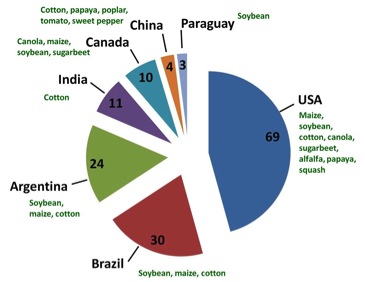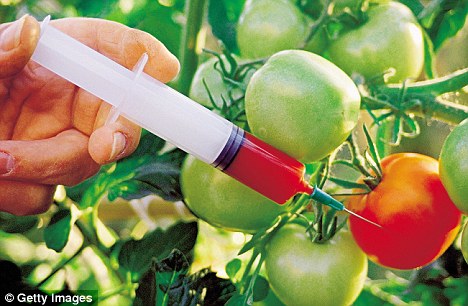A Genetically Modified Organism (GMO), to be stated in a simple definition, is an organism – plant or animal – which is genetically modified so as to acquire a desired characteristic which may have been present naturally in another organism of a different species. Nowadays, it may have a number of variations, like modifying the genes of an organism so as to shut ON/OFF a protein translation which may have a phenotypic impact on upcoming generations. While it is practically a tedious task to develop technologies to develop clones of GM mammals like humans, bovines and suids, there have been a few successful exceptions. But it has been comparatively easier to produce GM crops on a large scale which is now dominating the agro-based food consumption in many parts of the world.
If we focus on a few GM crops and their major consumers , USA leads all the way, followed by Brazil. Though we find India to be on 4th spot on overall levels of production, it involves only cotton.

Source : www.isaaa.org
The GOOD
What is the need of a Genetically Modified (GM) crop overall ? The answer to this question varies from individual to individual and from support groups to support groups. But to throw some light from a common man’s perspective, it has many benefits for human kind.
- It can potentially improve the crop yield, which will have a tremendous impact to feed a large population
- It is claimed to be more economical in the long run, despite the initial higher cost of the seeds
- It supposedly reduces the need of pesticides, herbicides and manpower
- It may lead to improved financial gains
- It has certainly proven to improve certain qualities of crops (e.g. shelf life in Tomato)
- It may lead to crops with higher tolerance to temperature and weather fluctuations
- It may lead to higher production of a certain essential nutrient which may be required by the local population (e.g. higher Vit. A content in ‘Golden Rice’)
The BAD
So why inspite of these advantages are we questioning the methods of GMOs ? This answer is also varied, but certain limitations and constraints are common to many different think tanks.
- Certain foods trigger an allergic response either to an entire species or to certain individuals or groups of individuals. GM crops may have a horizontal gene transfer from other species which may either trigger an allergic response or provide a completely new set of allergens
- It is great that we have developed certain plants that actually produce metabolites that kill certain pests. But what i the pest itself is a significant part of the food chain and its mass killing or reduced numbers disturbs the stasis of the ecosystem’s food chain. Certainly this will trigger a region’s biodiversity.
- Increasing production of pest-resistant crops will lead to species starvation which may reduce in population or go extinct owing to lack of proper food resources
- Since many GM crops are developed using bacteria and viruses, there is a fear of emergence of new and potentially harmful diseases for humans and domestic animals
The NECESSITY
If we narrow our perspective for India and focus on our needs and requirements, the scenario changes a little. Our current state of existence is quite different from the countries where the concept of GMOs developed and the manner in which it was intended to be used. Certainly, our demographic magnificence is a major factor which we need to include, along with the cultural diversity which influences our food habits, the level of poverty, the kind of diseases and water availability, which still vary a lot.
Why are GM crops GOOD to be used in India ? A simple answer lies in the fact that a large population is to be fed, despite of the natural calamities like floods, droughts and extremities of temperature. Weather and temperature tolerance coupled with increased water retention capacity and osmotic stress tolerance, all will help us maintain our stockpile of resources and feed to ever-growing population. Regions where people have diverse food habits including vegetarianism and vegan-ism, people are more prone to nutritional deficiencies rather than physical health problems. Providing a crop with increased amount of the nutrient will benefit the local population if not the entire lot.
Why are GM crops BAD to be used in India ? When we want a sustainable environment for the Indian citizens as a whole, we need to think organic. Chemically treated farmlands (as in case of pesticide resistant GM crops) affect not only the local areas, but seepage of chemicals during rainwater or river-water run-offs allow the consequences to penetrate in the neighborhood as well. Plus, as it has already being observed although unproven, the health consequences due to pesticides, herbicides being consumed along with the food has completely dominated other small problems that were accounted while developing GMOs. The rate of physiological health problems like lung disorders, heart disease, urinary and GI malfunctions have increased manifold in correlation with the timeline for development of GM crops.
It is we as responsible citizens of our country who need to decide about the future of our children and the ever-lasting impact of the short-living benefits that we may enjoy today.
Click here for government certification in Health, Nutrition and Well-being





13 Comments. Leave new
Well explained!
Chemicals affects all things.. nice work..
You have talked about a very important topic…excellent work..
Good article. Well done.!
Unique, interesting and informative article.
nice work!
nice post..well done
Important topic.. very well explained.. good job..
Great job. Explained both sides.. well done.
Very well researched topic 😀
Good work 😀 ..
The content as well as the presentation was really nice ,with bullets and info used at the right time 😀
The protest on BT brinjal and other genatically modified stufs are still ongoing 😀
Keep it up 😀
As its something that everyone should know 😀
Good job 🙂
A must read
Well explained!